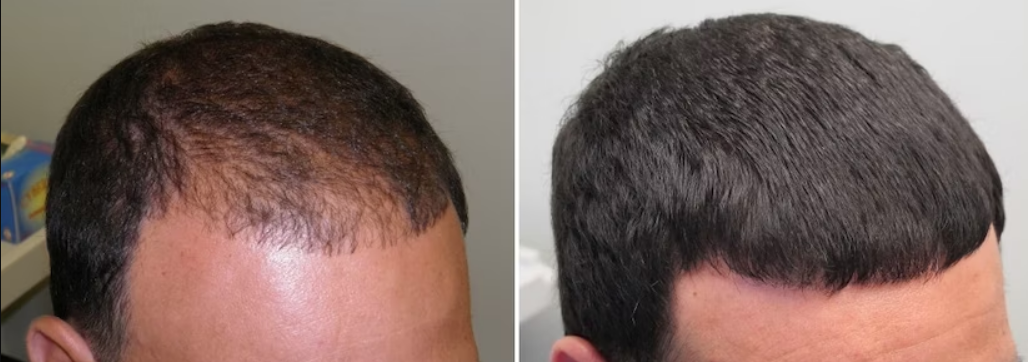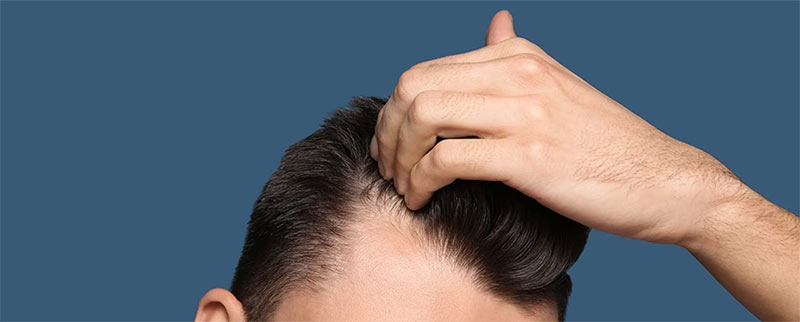Patients often ask what kind of timeline they can expect to see results if they start taking finasteride (Propecia) 1mg daily for hair loss treatment. They want to know when they’ll start seeing changes and how long it takes for finasteride to work fully. In this evidence-based guide, I’ll break down the finasteride results timeline based on clinical studies and real-world data.
1 Month – No Visible Changes Yet
Don’t expect to see any obvious changes in hair fullness after 1 month of taking finasteride. The drug needs more time to build up sufficient levels in your body and exert its effects. Stick with it – improvement will begin gradually. Taking “before” photos can help you monitor progress month-to-month.
2 Months: Possible Initial Shedding
Some men notice increased hair shedding around the 2-month point. This is actually a positive sign – it reflects finasteride pushing out old, damaged hairs to make room for new growth. Power through the shedding phase knowing it resolves quickly.
3-4 Months: Early Signs of Improvement Emerge
This is when most men on finasteride 1mg daily start to notice some initial positive changes – less hair coming out during washing/brushing, slower hair loss progression. However, the new hair growth is subtle at first. Look closely for emerging baby hairs along the hairline and temple areas.
6 Month: Noticeable Improvements
Clinical trials showed 50% of men saw a noticeable improvement in hair growth and thickness after 6 months of finasteride. However, the full, maximal finasteride effects emerge over a longer duration of treatment. Stick with it – the best is yet to come!
9-12 Months: Robust Regrowth Should Be Evident
In most users, this time period is when the regenerative effects of finasteride really begin to kick into high gear. More significant filling in of thinning areas and re-growth should now be plainly visible. You should see less hair shedding and feel your hair looking thicker, fuller and healthier.

18-24 Months: Full Effects Achieved
It takes a good 1-2 years of continuous finasteride therapy for the full, maximal results to be seen. Studies found finasteride showed increasing efficacy out to 2 years for stabilizing hair loss progression and regrowing stronger, thicker strands. The wait is well worth it!
The Key Takeaway Points to Remember
The most important finasteride timeline reminders I give patients are: 1) Be patient – the peak, maximal effects take 1-2 years to emerge. 2) Consistent daily use is critical to see the best results long-term. 3) Take periodic photos to better appreciate the gradual improvements. 4) Don’t get discouraged by initial shedding – it’s just the new growth beginning! Let me know if you have any other questions!
Potential Finasteride Side Effects
As pharmacists, we frequently have patients asking about finasteride (Propecia) for treating male pattern hair loss. When dispensing finasteride, it’s essential that we educate patients about potential side effects, their likelihood, and when to seek medical advice. This detailed guide examines the possible side effects of finasteride based on clinical evidence.
How Finasteride Works
Finasteride is an oral medication that treats hair loss by blocking 5-alpha-reductase, an enzyme that converts testosterone into DHT. Excess DHT contributes to hair follicle miniaturization and eventual balding. By lowering DHT levels, finasteride helps reverse this process and allow renewed hair regrowth.
Sexual Side Effects
Decreased libido, erectile dysfunction, and reduced sperm production are possible finasteride side effects related to lowered DHT levels. However, clinical trials show these sexual side effects occur in less than 2% of men on the 1mg daily dose for hair loss. The effects are reversible with dose adjustment or discontinuation.
Breast Enlargement and Tenderness
Some men notice breast tenderness or enlargement (gynecomastia) while taking finasteride, likely due to shifts in hormone levels. However, long-term studies found less than 1% of men developed persistent breast changes. Mild cases often resolve spontaneously. Seek medical advice about pronounced symptoms.
Allergic Reactions
As with any medication, finasteride can potentially cause hives, rash or more serious allergic reactions like swelling and difficulty breathing. Allergic reactions are rare, but seek prompt medical care if they occur. Milder skin reactions generally resolve without treatment.
Mood Changes
There are isolated post-marketing reports of depression, anxiety and insomnia. However, controlled studies found no definitive causal link between finasteride and psychiatric issues. Discuss any new mood symptoms with your doctor to determine appropriate evaluation and treatment.
Other Uncommon Effects
Headache, dizziness and digestive upset are other possible finasteride side effects. Cranberry juice can help with urine flow issues. Muscle aches or testicular pain may also rarely occur. Inform your doctor about any bothersome symptoms.
How to Use Finasteride for Best Results
As pharmacists, we want to help patients get the most effective results from medications like finasteride for treating hair loss. While finasteride can help stop hair thinning and regrow stronger strands, its success depends largely on proper use. In this detailed guide, I’ll provide evidence-based tips to help you optimize finasteride’s effectiveness based on clinical studies and real-world data.
How Finasteride Works
Finasteride is an oral medication that treats male pattern baldness by blocking 5-alpha-reductase, an enzyme that converts testosterone into DHT. Excess DHT shrinks hair follicles, eventually causing them to stop producing visible hairs. Finasteride lowers DHT levels, allowing hair follicles to regain normal size and initiate new growth.
Be Patient for Results
It takes time for finasteride to work. Most men see the first subtle improvements around 3-4 months. But the full effects take 1-2 years of consistent daily use. Have realistic expectations about this gradual timeline and don’t get discouraged early on. Positive changes happen slowly.
Take Finasteride Consistently
Daily finasteride is necessary for optimal results. Sporadic or occasional use won’t provide much benefit. Set a daily reminder and establish a regular routine for taking your 1mg finasteride tablet. Consider using a pill organizer too. Don’t skip doses.
Continue Finasteride Long-Term
Clinical studies found finasteride efficacy continues increasing with longer-term daily therapy. Whereas after just 1 year results can seem mediocre, at 5 years they are quite substantial. And benefits are maintained out to 10 years. Commit to using it long-term.
Combine Finasteride with Other Treatments
Using finasteride along with minoxidil solution/foam and DHT-blocking shampoos produces better results than just one treatment alone. Laser hair growth devices can also complement finasteride. Employ a multi-therapy approach for best effects.
Monitor and Compare Progress
Take photographs at regular intervals to better visualize subtle changes over time. Compare photos month-to-month and year-to-year. This helps motivate you to stick with treatment by seeing the gradual but positive improvements.
Communicate With Your Doctor
Inform your doctor at follow-up visits about any side effects or issues with treatment. They may adjust your finasteride dosage, add complementary therapies, or switch medications if needed to help optimize your results. Be open about your response.
Have Realistic Expectations
Understand that for many men, simply halting further hair loss and maintaining one’s current hair is considered a successful treatment. Some regrowth can occur but is highly variable. Discuss your particular case with your doctor.
